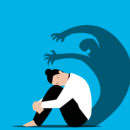Pure-O OCD (Pure Obsessional OCD): Hidden Rituals
“Pure-O” OCD, or Pure Obsessional OCD, is a relatively less common form of OCD that seemingly differs from classic presentations of the illness. What distinguishes Pure Obsessional OCD from classic OCD is that in Pure-O OCD, symptoms are predominantly obsessive (rather than compulsive) in nature. Although individuals with Pure-O OCD frequently experience intense and distressing obsessions, they typically report few (if any) overt compulsive behaviors. However, in almost all cases, pure obsessionals do engage in a variety of rituals. These rituals just manifest as mental compulsions rather than behavioral compulsions. Unfortunately, most psychologists haven’t been trained in how to ask the types of questions that are necessary to identify these “hidden rituals.” As a consequence, these rituals often go undetected. Because effective treatment requires consistent response prevention, a failure to recognize and resist mental compulsions makes true exposure and response prevention (ERP) impossible. Treatment...
Read MoreExposure & Response Prevention (ERP) for OCD: Treatment Mechanism
How does ERP work? What mechanism underlies it? Obsessive-compulsive disorder (OCD) is characterized by obsessions and compulsions. Obsessions are disturbing thoughts, images, or impulses that increase feelings of anxiety. Compulsions (also known as “rituals”) are the strategies that individuals with OCD use to reduce the anxiety associated with obsessions. Rituals are effective coping strategies in the short-term, in that they lead to fairly rapid decreases in anxiety. However, rituals are considered maladaptive, because the anxiety relief they bring is short-lived. Engaging in rituals ultimately increases the likelihood that obsessions will be re-experienced in the future. This can be thought of as a positive feedback loop, in which compulsive behavior indirectly reinforces obsessions. This is depicted in the bottom half of the included figure. The treatment of choice for OCD is exposure and response prevention (ERP), which not surprisingly, has...
Read MoreObsessive-Compulsive Disorder (OCD) – Overview
What is OCD? Obsessive-compulsive disorder (OCD) is a debilitating mental illness that affects nearly 2.5% of the population (American Psychiatric Association, 2000). The primary features of the disorder include obsessions, which are recurrent and persistent thoughts, impulses, or images that cause severe anxiety and distress; and compulsions, repetitive behaviors or mental acts performed in response to an obsession. Compulsions frequently are performed to reduce distress or prevent a dreaded event or situation from occurring. Because individuals with OCD often spend many hours each day experiencing obsessive-compulsive symptoms, the disorder severely impairs functioning across a variety of domains. According to Rasmussen (2005), individuals with OCD tend to adhere to highly rigid and disciplined notions about how to do things properly, “sacrificing opportunities for positive, pleasurable activities to maintain a position of disciplined appropriateness” . Consistent with this view, cognitive rigidity...
Read MoreOCD, ERP, & doubt sensitivity: Shattering the illusion of certainty
Many individuals with OCD hunger for certainty. It’s a craving that often can’t be easily sated. Early conceptions of OCD from the 19th century acknowledged this issue directly, in that OCD was often termed the “doubting disease.” It is this need for certainty, the need to eliminate doubt, that leads many people with OCD to perform repetitive behaviors, which are known as rituals. For example, it is doubt about whether one’s hands are sufficiently clean that leads one to engage in repetitive hand-washing rituals. Likewise, uncertainty about whether a stove has been turned off (and worry about potentially dire consequences) can underlie checking rituals. Many different types of rituals involve reassurance-seeking behaviors. For people with OCD who have intrusive bad thoughts (e.g., What if I secretly want to hurt a family member? What if I don’t believe in God...
Read MoreOCD symptoms: the obvious (and the not so obvious)
Symptoms of OCD are everywhere. Turn on your television, and you’re likely to catch at least a fleeting glimpse of obsessive-compulsive disorder (OCD). Many popular TV shows feature characters with OCD (e.g., Emma on Glee, Monk), and it is through this lens that many members of the general population get their first exposure to OCD. Unfortunately, if your understanding of OCD is based solely on depictions in the popular media, you are likely to have a relatively limited (and perhaps, warped) sense of what OCD really is. The truth is that OCD symptoms can manifest in many different ways. Although some symptoms are more common (e.g., a fear about about germs or getting sick), other symptoms can be quite idiosyncratic and often go undetected by inexperienced psychologists. The unfortunate consequence of this is that many people with OCD don’t...
Read More







